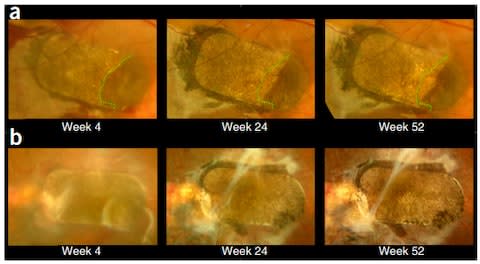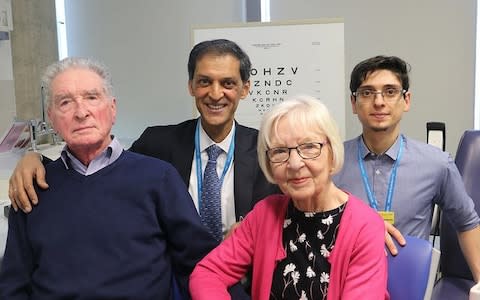Stem cell patch allows word-blind patients to read again

Two patients suffering the most common form of sight loss in Britain can read again after a groundbreaking stem cell patch was transplanted into their eyes.
An 86-year-old man, and a woman in her 60s, had both been diagnosed with wet age-related macular degeneration (AMD), a condition which causes loss of central vision.
AMD affects more than 600,000 people in Britain and occurs when the specialised light-sensitive cells at the very centre of the retina - a region called the macular - become damaged.
Currently the only treatments available are injections into the eye, or laser surgery, which both slow the growth of blood vessels which harm the macular. However they only partially restores sight and do not work for everyone.
Now scientists at University College London (UCL) and Moorfields Eye Hospital in London have shown sight can be restored using a patch of stem-cells which replenishes the damaged area.

In a two hour operation, specialists inserted the patch under the retina of each patient, who were then monitored for a year. Both went from not being able to read at all, to reading up to 80 words-a-minute using normal reading glasses.
Douglas Waters, 86, from Croydon, London, was one of two people who had received the treatment at Moorfields Eye Hospital. He developed severe wet AMD in July 2015 and received the treatment three months later in his right eye.
“I was struggling to see things clearly, even when up-close,” he said. “After the surgery my eyesight improved to the point where I can now read the newspaper and help my wife out with the gardening.
“It’s brilliant what the team have done and I feel so lucky to have been given my sight back.”

Experts said the treatment offered ‘real hope’ to people suffering from AMD.
Professor Lyndon da Cruz, consultant ophthalmologist at Moorfields Eye Hospital NHS Foundation Trust said: “The patients who received the treatment had very severe AMD, and their improved vision will go some way to enhance their quality of life.
“We recognise that this is a small group of patients, but we hope that what we have learned from this study will benefit many more in the future.
“The results suggest that this new therapeutic approach is safe and provides good visual outcomes.”
The patch was grown on a thin plastic scaffold from human embryonic stem cells. Rather than replacing the damaged light-sensitive cells themselves, the sheet comprises of a single layer of retinal pigment epithelium, a specialist tissue which provides support for the light cells, keeping them healthy and promoting regeneration.
Previously stem cells have been used to help AMD sufferers, but it is the first time a patch has been grown and transplanted.
It is the first time an engineered piece of tissue has been successfully used to treat people with sudden severe sight loss. The new therapy will need to go through larger trials and then be passed by regulators, but researchers believe it could be available in eye clinics in as little as five years.

Professor Pete Coffey from the UCL Institute of Ophthalmology said: "This study represents real progress in regenerative medicine and opens the door on new treatment options for people with age-related macular degeneration. "We hope this will lead to an affordable 'off-the-shelf' therapy that could be made available to NHS patients within the next five years."
Commenting on the research Dr Carmel Toomes, Associate Professor, Leeds Institutes of Molecular Medicine, said: These results give the many patients out there who suffer from AMD and other retinal degenerations real hope that stem cells replacement therapy may be a reality in the near future.
“While this is only a very early clinical trial, the results are positive and show that the technology is moving along in the right direction.”

Dr Dusko Ilic, Reader in Stem Cell Science, King's College London added: “Even though still in the experimental stage, encouraging results from the da Cruz team are reducing further safety concerns with the human embryonic stem cell based therapies.
“They represent another step forward in materializing our hopes of clinical implementation of human embryonic stem cell based treatment of age-related macular degeneration in the not so distant future.”
The trial results were published in the journal Nature Biotechnology.

 Yahoo News
Yahoo News 